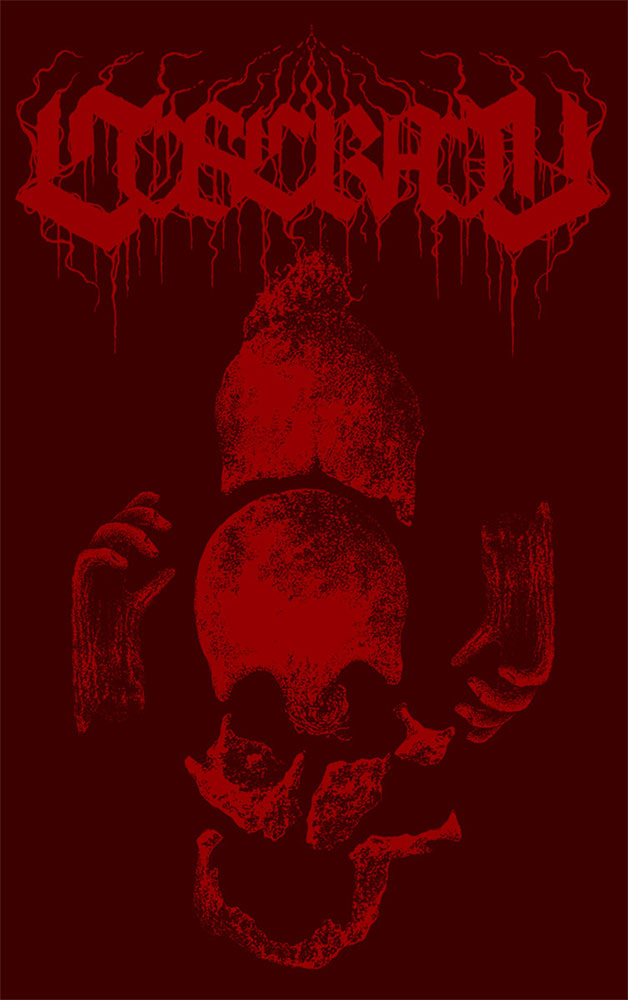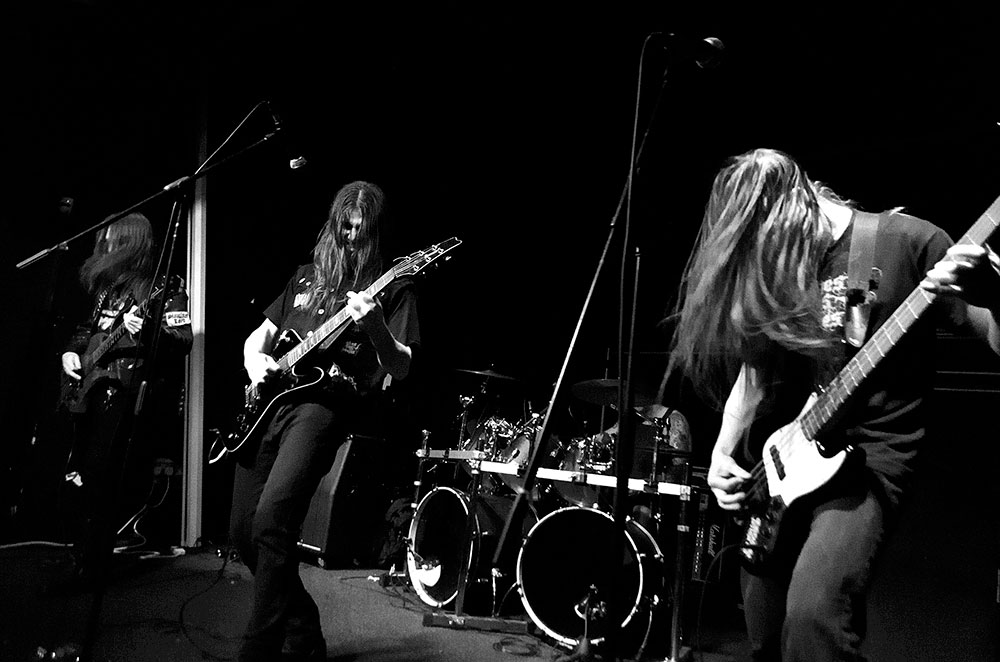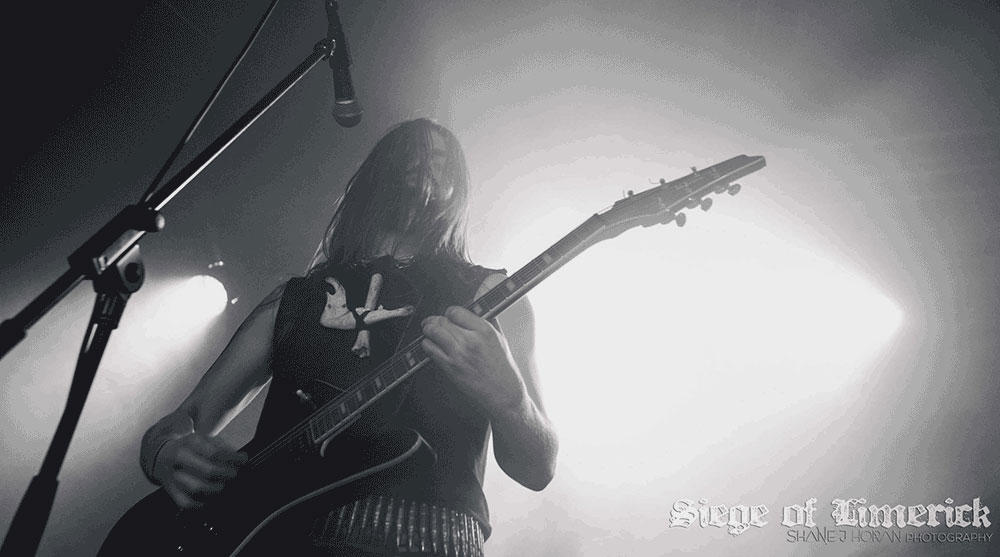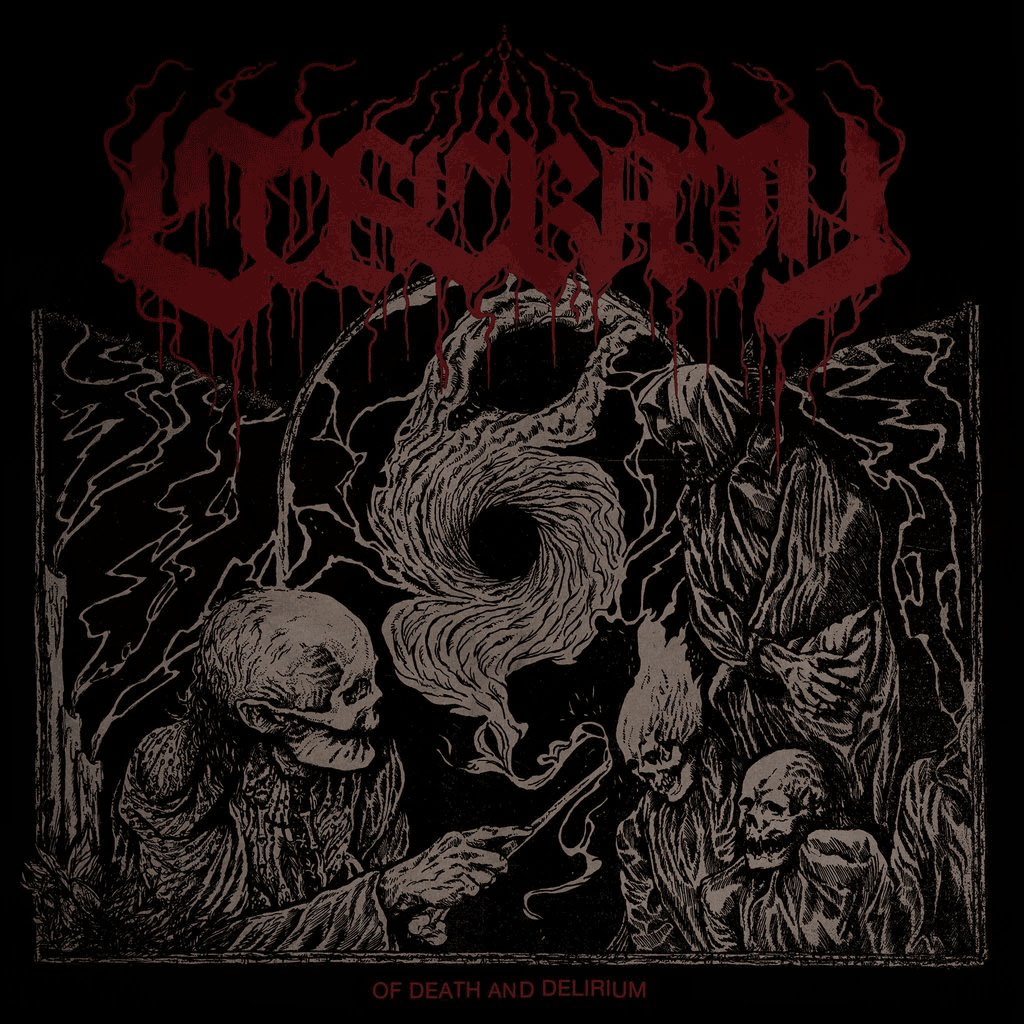Coscradh
2018-05-23
by Niklas Göransson
Irish black/death metal band Coscradh have no need for infernal fantasies, opting instead to explore the harsh reality of their nation’s history. Guitarist Ciarán Ó Críodáin speaks of the threefold ritual death and calls for a return to barbarism.
– I got in touch with John (guitars) in 2014, we’d previously met at the Warzone Centre in Belfast and found ourselves equally unamused by the local punk bands on display, as well as being completely on the same page musically. Neither of us had much previous band experience and without any sort of ambition in mind beyond creating a demo, we spent long evenings throughout the year drinking heavily, listening to records and writing the original guitars and vocal arrangements. We finally became a ‘real’ band upon finding our drummer, Karl, in early 2015. To do justice to the vast technique and experience he brought to the table, the songs were rearranged and the dynamic shifted from the intended rough four-track DIY style to the current, properly audible content as heard on the aforementioned demo.
Ciarán says that when first setting out, their idea was to create deranged, violent and primitive sounding black/death metal with a mixture of energetic, mid-paced, and doom-ish song-writing influenced by the likes of ROOT, TÖRR, MYSTIFIER, SLAYER, GOATLORD, RIDE FOR REVENGE, VOMITOR, HELLHAMMER, and CULTES DES GHOULES.
– What we didn’t want to do was add ourselves to the existing sea of black and death metal bands who all sound the same and base themselves around a forced obscurity or satanic fantasy. We felt that there’s enough profound barbarism and violent insanity in Ireland’s history to dedicate our sound and lyrics to it. To set ourselves apart from other Irish bands who write about national heritage, lyrically I try not to focus on mythology, recent history, or politics. Though it’s obviously appreciated that some myths and legends are steeped in true history with oft-blurred lines, the lyrics attempt to come from a place of brutal reality.
After much deliberation, they settled on the name COSCRADH.
– Found in the Annals of Ulster, it’s an Old-Irish word describing the result of a battle ending in massacre – a slaughter or triumph in barbarous one-sided victory, as opposed to other outcomes such as rout or defeat. It’s also been used for the act of hacking and dismemberment. Violent and to the point, a suitable embodiment of the projected lyrical content and sound: perpetual death.

“Buried”, “Lynch”, and “Drowned” – the first trilogy of tracks from the self-titled 2016 demo – each signify one aspect of the threefold ritual death employed by druids of ancient Ireland in carrying out human sacrifice. The demo concludes with the song “Coscarṫaċ”, which airs sentiments of re-introducing such practices to contemporary times.
– “Coscarṫaċ” is written as a wish to return modern-day Ireland to more barbaric times, be it the 1700s or 3000 BC; it amalgamates the other three songs in a metaphoric return of wolf and snake. It depicts the utter disgust held by druids resurrected from their burial sites and seeing the desecrated land and its current inhabitants – how they overturn modern times with one barbaric curse of uncivilisation.
And what would be the upside to societal collapse – reckon you’d thrive on The Road?
– Of course – eating the weak! Actually, The Road is one of my personal favourite books and films. I’m not sure if my lyrics sent you down that path or if your mention is just a coincidence because perhaps it had some kind of unconscious effect on the song.
The Cormac McCarthy book in question is probably the most believable post-apocalyptic depiction I’ve read, so that’s what came to mind.
– Even for an island so rich in culture and with such unique history, long and obscure, we are now four minutes behind the US with everything. Our young have no interest in where they came from. It’s probably the same with every generation but its exponentially running away from us with globalisation. The ancient beliefs are ingrained in the rural people themselves and interest in old stories and superstitions are not being passed on to younger generations. Granted, in the modern age there are positives to having been born into an English-speaking country but – even if Ireland still has a strong heritage in music, literature, poetry, and sport – having lost our language to the plantations of our dearest neighbour has left us with no barrier of defence and we’re the first victims of this cultureless uniformity between Western members of the former British empire.
Ciarán says that as Ireland’s older generations go to their graves, they take with them about ninety percent of local stories, customs, and lore.
– Those threads of history come to an end there, and not even with today’s unlimited storage capacity can we do a good job of preserving it. This fact was actually recognised by the newly formed government in the 1940s and to help increase the new state’s sense of national identity – separate from the British – there was a school project of sending out every pupil to interview the old and each retrieve at least one story. This was then archived and will finally see the light of day later this year. A feat of noble and hopeful plight but in a sea of terrible ideas, with the new state’s identity depending too much on intertwined Catholicism.
Not only are the collective memories fading, Ciarán mentions as a grave concern lack of care for historical sites from the authorities.
– I recently visited a fort situated on a cliff-face, estimated to date from about 1100 BC. Places such as these are said locally to have had ritual significance for worshipping Manannán, the god of the sea. Still, this site was only investigated by archaeologists in the last couple of years. Now, admittedly, I’m pretty ignorant regarding the logistics of archaeology but to me it’s pretty amazing how it had been neither excavated nor carbon dated before then. There are many sites in Ireland located on private property, completely at the mercy of the land owner. Where I grew up, Connemara in County Galway, a castle belonging to one of the ’fourteen tribes of Galway’ was bulldozed to the ground by a hated local farmer who was angry about people trespassing on his land to see it. Flags of all tribes are proudly displayed in the region’s city centre, yet this despicable act was fully legal and nothing could be done about it.

The hypothetical story of “Buried” plays out at the end of a failed harvest, signified by the waning moon, and spells disaster for a people who realise they might not survive the winter. With great power comes grave responsibility, so the king is held accountable and no longer seen as legitimate.
– In the course of an early democratic process, he’s brought out into the boglands and ritually executed by sword. Matt Salters brings this concept to life in the cover artwork. Human sacrifice was a common part of life across the entire world until the rise of Rome, an empire whose wealth had long since left them disconnected from the older way of life. It’s ironic to note that while the Romans reviled practices of human and animal sacrifice, they themselves built fantastic arenas for the same purpose. Druids had a massive influence in the daily lives of people and their rulers, which is why early texts about our history written by the Romans intentionally depict Gauls as barbaric.
The idea behind “Buried” stemmed from the December 2012 discovery of what would come to be known as the Moydrum Man; a corpse found in a swamp, radiocarbon dated to between 700 and 400 BC. This is one of Ireland’s so-called bog bodies – preserved through the ages by natural mummification in oxygen-free, acidic, and cold mud. Examining previous such findings led experts conducting a 2010 study published in Archaeology Magazine to conclude that the men who’d undergone ceremonial execution and torture were most likely failed monarchs and chieftains.
– Ritual sacrifice on this side of the world was actually disputed until fairly recently, but according to hitherto unproven Roman texts the druids would cut offerings in the victim’s spine with a sword – then make predictions of prophecy based on the convulsions, death throes, and patterns forming from the blood. One such bog body bore lacerations across the back, another had ropes threaded through his arms and was cut in half from the waist. Signs of nobility in diet and clothing were found on the bodies. At similar sites it’s been strongly suggested that human sacrifice was carried out by the druids, who in the people’s eyes superseded kingship.
Among the ancient Celts, druids were a form of cleric, scholar, and mystic; their first appearance in the historical records dates to 3rd century BC. The druids appear to have some similarities to the Brahman caste in Hindu society – in fact, several scholars have suggested them to be separate offshoots of an archaic Indo-European priesthood. Other historians have described their function as similar to that of shamans in tribal communities. They were highly revered and appear to have functioned as judges, teachers, and priests. Civilians foolish enough to disobey their verdicts would be handed the worst conceivable punishment: being barred from attending sacrifice. As part of their education, a tuition process that could take up to two decades, adepts would study philosophy, astronomy, spirituality, and science. Not much is known about their theological doctrine besides that it was rooted in the fundamental principle of the human soul as immortal, passing from one vessel to the next. 1st century BC Greek historian Alexander of Miletus described their beliefs as similar to the Pythagoreans. Interestingly, the Hellenic scholar – who’d been enslaved by the Romans and subsequently granted citizenship – also suggested that the roots of Greek philosophy lay not only in the druids of Gaul but also the prophets of Egypt, shamans of Bactria, philosophati of the Celts, and Persia’s Magi. An annual druidic assembly was held in Carnutes, located somewhere in nowadays France and, at the time, the heart of Gaul. The druids appear to have recognised the threat Christianity posed to their existence at an early stage; an analysis which, could be assigned some retrospective validity, given how little their descendants know about them today.
– Despite training for twenty years, the druids didn’t write down their history or share their deeper knowledge with the public. In Ireland, they’re even said to have had their own language separate from Old Irish, which in itself is very difficult to decipher even for the most fluent of Gaelic speakers today. A national order of druids in Gallic Europe had gatherings based around philosophy and politics. Besides spreading the teachings of their own gods and being politically savvy – with kingdoms rising and falling at their behest – the druids had deep knowledge of the world around them: healing, law, and astrology. The Romans were fully aware of this and feared the power they wielded over the Gallic people, from peasant to king, which is why the druids themselves were one of the empire’s earliest targets.
They believe, in effect, that, unless for a man’s life a man’s life be paid, the majesty of the immortal gods may not be appeased; and in public, as in private life they observe an ordinance of sacrifices of the same kind. Others use figures of immense size whose limbs, woven out of twigs, they fill with living men and set on fire, and the men perish in a sheet of flame. They believe that the execution of those who have been caught in the act of theft or robbery or some crime is more pleasing to the immortal gods; but when the supply of such fails they resort to the execution even of the innocent.
Caesar, 100 BC – 1 AD.
– The Roman texts are normally taken with a pinch of salt, as they should be. The propaganda put forth in these writings aided the war effort against the Gauls and in converting their people to Roman philosophy. At some point during the 3rd and 4th centuries, Irish clans converted to Christianity and built monuments and churches on old burial grounds and ritual sites. Priests have been responsible for a lot of lost history down through centuries, destroying older symbology of opposing gods and erasing direct references to druids from early texts. Even now there was a fairly recent case coming to light of a priest removing the ancient symbol of ‘sheela na gig’ from a church in County Wicklow. There is, of course, still a lot of symbology remaining on buildings not associated with the church that people have fondly preserved over time. One of the most prominent being the severed head which was widely used by Irish druids who, as opposed to their European counterparts, fought on the battlefield. It can be seen on castles up to the 17th century and, apart from its obvious function for intimidating enemies, was meant to signify the secrets of their complex religion with the head serving as seat of one’s soul and the centre of being.

The gallows song, “Lynch”, takes its name after the main protagonist from another colourful episode of Irish history. Galway city had fourteen iconic trading families – the line of Lynch among them with its patriarch having served as Mayor of Galway between 1493 and 1494. While there’s no official documentation corroborating the tale, it’s said that his son murdered a love rival and then sought refuge in the family mansion. Upon discovering the crime, a mob of townspeople besieged the residence demanding justice. Being a principled man and seeing no other way out, James Lynch fitz Stephen tied a noose to the windowsill and hung his son from it. In 1854, Galway city officials erected a monument commemorating the event. Its inscription states:
This ancient memorial of the stern and unbending justice of the chief magistrate of this city James Lynch Fitzstephen elected Mayor A.D. 1493 who condemned and executed his own guilty son Walter on this spot has been restored to this its ancient site A.D. 1854
– “Lynch” is probably the song of ours I’m most proud of, having had my hometown give birth to such a terrible phrase as ‘to lynch’. PRIMORDIAL most recently wrote about the same story on “To Hell or the Hangman” from their new album, which I found most surprising as it’s an old tale that wouldn’t be familiar to many non-Galwegians. Being a fan of PRIMORDIAL’s lyrical content and most of their work for well over a decade, I thought this was great. There’s one very defining difference here though and it’s fairly self-explanatory: they wrote about the tragic tale of the son, Walter, his terrible deed and its punishment, whereas ours is told from the father’s perspective – a maddened lynching of his own child, dragged in from the safety of the family’s mansion and hung from the window by the strength of his own hands in front of an enraged mob. “Lynch” is actually not the only COSCRADH song drawing on the element of killing one’s offspring. I felt that the story of Betty Sugrue, the merciless hangwoman, was an apt subject matter for us – which is why she’s excellently illustrated on Jack Welch’s cover artwork for “Of Death and Delirium” (2017 EP).

’Lady Betty’, born in the early 18th century, became a public executioner renowned for her cruelty. Long before then, with her husband dead and two children to care for, she set out on the 240 kilometre walk to Roscommon town in hopes of improving their situation. Upon journey’s end, one of her young had succumbed to starvation along the way. Sugrue and her remaining son arrived in Roscommon and fell into a life of crushing poverty – residing in a shack and forced to beg for food. Clinging on to her last threads of sanity, Betty’s notoriously vicious moods and over-protective obsession made her son Padraic’s life even more miserable. In 1775, and despite his mother’s incessant pleading, he travelled across the Atlantic to seek a better life in America where he joined the Continental Army. He would send his mother money and letters but she was unceasing in her hysteria, sowing further hostility between them. Back in Roscommon, years of solitude and joyless sorrow had left Betty a cold and hard woman. She’s said to have dwelt in social isolation, venturing out only for food. It would thus have been with some surprise she one evening in 1789 received a bearded visitor with a peculiar accent, requesting lodgings for the night. The stranger claimed the local inn was full and asked to sleep in her hovel, offering a gold coin for her troubles. Having spotted his filled pouch and surmising him to be wealthy, Betty offered him her bed. Stewing over the grave injustice of being forced into such an utterly miserable existence while random travellers strutted around carrying a minor fortune, she waited until he was asleep and then stabbed him to death. Alas, her new life as a wealthy woman would soon take an unfortunate twist when, after going through the victim’s pockets, Betty was dismayed to discover that she had just murdered her only surviving child. It’s said that Padraic refrained from identifying himself in hopes of first getting a fresh estimation of his mother, so one would have to assume that shock horror would’ve been the concluding analysis. Betty was sentenced to die by public hanging together with twenty-five other assorted criminals. The already riotous crowd became increasingly agitated upon news of the town hangman having been stricken with disease and rendered unable to carry out his duties. With concern presumably yielding to astonishment, the sheriff found an unlikely solution when Betty Sugrue offered to step in as deputy hangwoman. Rid of manacles, she disposed of her former comrades in an orderly fashion. By the end of the day, the condition of the hangman worsened and he perished. The sheriff anointed Sugrue as his replacement, installing her in proper lodgings within the prison grounds. The new executioner quickly garnered a reputation for her terrifying efficiency, and seemingly derived great pleasure in carrying out duties such as flogging prisoners. She became known locally as ’woman from hell’. Betty finally retired in 1802 and was allowed to live out her days caring for her little prison garden. Roscommon’s hangwoman died five years later and was laid to rest in an unmarked grave.
– It’s very typical for Irish tales and history to end in defeated tragedy or with some weakened, wretched and doomed character. One could perhaps mistake Betty’s story as such, but that’s not at all how I envisage Sugrue. Hers is in fact a tale of bestial survival instinct and a complete loss of any sort of human weakness by surviving through great strife. Neither tragedy nor defeat here, it is in fact a total victory. Similar to the tragic death marches of the Irish Famine – starving, she walked for over 150 miles, first losing one child and then murdering the other herself. But in contrast to the ultimate end faced by millions, she survived her own death-march. Even throughout the 1798 Rising, the most gloriously tragic story of how our island nation came to be, she remained indifferent. Sugrue unsympathetically executed members of this cause herself, along with anyone else in front of her. Not for being on the right or wrong side of history, nor for any agenda – she stood for nothing but herself on her own terms; a woman who survived on the land’s true ancient barbarity and her own gut instinct.



